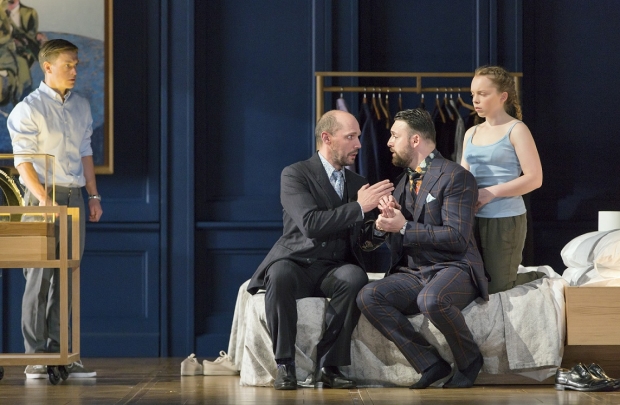Review: Lessons in Love and Violence (Royal Opera House)
George Benjamin and Martin Crimp follow ”Written on Skin” with another historical opera

© Stephen Cummiskey
These guys need no lessons from me. Thanks to the worldwide success of Written on Skin, the new collaboration between George Benjamin and Martin Crimp was a hit before it opened. Following this Royal Opera House premiere, Lessons in Love and Violence travels to Amsterdam, Hamburg, Chicago, Barcelona, Madrid – and to Lyon, the city for whose favourite son the main role was written.
That's Stéphane Degout, and although he's the King of England he is never named as Edward II, even though his lover is Gaveston and his queen is Isabel (which is almost Isabella). It's important not to get hung up on identities because this is a cerebral tale, largely interior in its mood despite the excessive verbiage of Crimp's libretto.
The King and Queen have two children, one of each. The bisexual monarch also has a male partner, an out-of-control loudmouth who is dispatched on the orders of the king's sinister adviser, Mortimer ("even his name means death"). The king, too, is killed, not by the red hot poker of history but by something closer to osmosis; whereupon his young heir adds a twist to the tale.
The seven scenes of this 90-minute opera are brief but they are not spare, and therein lies the problem. Crimp's libretto is so good it's bad. Rather than serve the composer's inspiration it's a tour de force in its own right that dominates the work's structure and reduces Benjamin to a glorified illustrator. For all the latter's gifts, this score is manifestly a setting of a pre-existing text rather than an organic collaboration and that is what sterilises it as drama. Imagine what this pair might have produced if they'd worked at the same desk.
Nevertheless, it's a masterclass of technical orchestration and note-placing. It is no surprise to learn that Benjamin studied his singers' voices closely and notated the score to suit their talents, for neither Degout nor Barbara Hannigan (as Isabel) has ever sounded more vocally voluptuous – a world away from the exquisitely chilly Pelléas et Mélisande they performed under the same director, Katie Mitchell, a couple of years back.
Typically, the music tracks Crimp's drama in long-phrased hairpins – crescendi and diminuendi – although the colours are more richly varied than that and even run to a scherzo (to which the young princess skips on a rope). The most prominent orchestral section in Benjamin's palette is percussion, redolent of Britten's for the beach games in Death in Venice yet wholly original in execution. It'll take further hearings to absorb the opera's aural universe more fully – a prospect to relish.
The singers, unsurprisingly, are exceptional. As well as Hannigan and Degout, Peter Hoare as Mortimer is in magnificent voice and Gyula Orendt adds baleful vocal variety as Gaveston, a gruff figure whom Crimp depicts as a pugilistic hothead. Samuel Boden makes a pivotal contribution as the Boy, as does the silent Ocean Barrington-Cook as his sister, and even Jennifer France pops out from an otherwise superfluous acting ensemble. Benjamin conducts his own opera with meticulous command and the ROH Orchestra responds to him with disciplined confidence. This is highly flavoured music: unmemorable on one hearing, perhaps, but impressive in its depth and detail.
Wisely, neither Mitchell nor her designer Vicki Mortimer overeggs this already rich pudding in the production. It is set in the unattributable present and never moves from the royal bedchamber, a decision that accentuates the opera's interiority. Those over-familiar Mitchellisms are thankfully at a premium (although she can't resist the temptation to slap on a slo-mo here and there) so her attention to characterisation shines through. It the most straightforward of this variable director's recent opera productions, and one of her best.


















